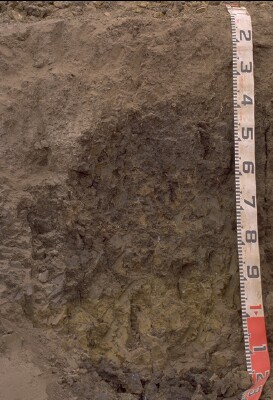SW83
Location: Warncoort
Australian Soil Classification: Vertic (& Calcic), Subnatric, Black SODOSOL
General Landscape Description: Gently undulating plain.
Site Description: Trough of a gilgai.
Geology: Basalt plain.
Soil Profile Morphology:
Surface Soil
| A1 | 0-10 cm | Very dark brown (10YR2/2 moist); loam; pH 5.5; clear change to: |  SW83 Profile. Note: Surface (A1) horizon has been stripped from the profile |
| A2 | 10-60 cm | Dark grayish brown (10YR4/2 moist) conspicuously bleached (10YR7/2 dry); sandy clay loam; apedal; massive; few (2%), fine buckshot nodules (concentrated in pockets); firm consistence dry; pH 6.6; abrupt and wavy change to: | |
| Subsoil | |||
| B21 | 60-90 cm | Black (10YR2/1 moist); heavy clay; few pockets of ferruginous fine gravel; coarse prismatic structure; pH 6.8; abrupt change to: | |
| B22 | 90+ cm | Gray (10YR6/1 moist) with very few (<2%) brownish yellow (10YR6/8 moist) and dark red (2.5YR4/8 moist) mottles; medium clay; medium prismatic structure; strongly vertic; soft calcareous segregations; pH 8.6. |
Key Profile Features:
- Strong texture contrast between surface (A) horizons and subsoil (B) horizons.
- Variable depth of A horizons due to gilgai microrelief.
Soil Profile Characteristics:
pH | Salinity Rating | |||
Surface (A1 horizon) | Strongly Acid | Low | Non-Sodic | None |
Subsoil (B21 horizon) | Slight Acid | Very Low | Sodic | None1 |
Deeper Subsoil (at 90+ cm) | Strongly Alkaline | Low | Strongly Sodic | Strong - Complete |
| 1 Complete dispersion after remoulding. | ||||

| The surface soil is strongly acid. The subsoil is slightly acid becoming strongly alkaline with depth. | Salinity rating is low in the surface becoming very low in the subsoil. |
| The clay content increases markedly at the A/B boundary. |
Horizon | Sample Depth (cm) | pH (water) | pH (CaCl2) | EC 1:5 | Exchangeable Cations | |||
Ca | Mg | K | Na | |||||
meq/100g | ||||||||
A1 | 0-10 | 5.5 | 4.9 | 0.21 | 6.2 | 3.2 | 0.61 | 0.37 |
A2 | 10-60 | 6.6 | 6 | 0.06 | 1.7 | 1.4 | <0.05 | 0.18 |
B21 | 60-90 | 6.8 | 5.6 | 0.11 | 5.9 | 11 | 0.3 | 2.4 |
B22 | 90+ | 8.6 | 7.5 | 0.25 | 7 | 12 | 0.28 | 4 |
Horizon | Sample Depth (cm) | Exchangeable Aluminium mg/kg | Exchangeable Acidity meq/100g | Organic Carbon % | Nitrogen % | Field Capacity pF2.5 | Wilting Point pF4.2 | Coarse Sand (0.2- 2.0 mm) | Fine Sand (0.02- 0.2 mm) | Silt (0.002- 0.02 mm) | Clay (<0.002 mm) |
A1 | 0-10 | <10 | 12 | 3.8 | 0.29 | 25.6 | 10.8 | 23 | 37 | 14 | 21 |
A2 | 10-60 | 3.3 | 16.6 | 3.8 | 29 | 46 | 14 | 12 | |||
B21 | 60-90 | 11 | 39.4 | 22.4 | 14 | 21 | 7 | 55 | |||
B22 | 90+ | 39.3 | 19.9 | 15 | 28 | 8 | 47 |
Management Considerations:
Subsoil (B) Horizons
- This profile is the “hollow” of a gilgai soil. See GP 82 for description of the associated “puff”.
- The subsoil displays vertic features (i.e. slickensides) which indicates that significant shrinking and swelling occurs during wetting and drying cycles. This may have engineering implications and is likely to explain the variability in surface horizon depth across the trench.
- Very variable between puffs and hollows. Intermittent/discontinuous cycle is every 2 - 3 m.
Profile Described By: Richard McEwan (March 1999).


